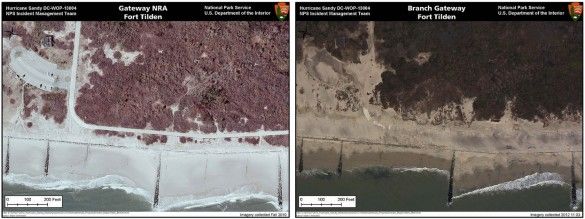Long Recovery Expected For Gateway Recreation Area

Six weeks after Superstorm Sandy struck the Gateway Recreational Area, a majority of the space remains closed, according to a New York Times report. The National Parks Service, which is in charge of the clean up, is facing an enormous task, clearing sand and debris from roadways, restoring drinking water and sewage treatment, and fighting mold breakouts in buildings where basements were flooded.
The National Parks Service has imported federal personnel from across the country to fill out and supplement Gateway’s staff, allowing for quick progress on the removal of sand and debris clogging the roadways.
The large crew faces tougher challenges than cosmetic ones like road clearing. Freshwater ponds in the Jamaica Bay Wildlife Refuge were flooded with saltwater when Sandy’s storm surge etched a new inlet in the Bay, breaching the natural separation from sea waters. In Sandy Hook, a wastewater treatment plant and a drinking water system were both disrupted by the surging waters.
Also hampering restoration were the presence of thousands of first responders who used the area to stage recovery operations. Gateway’s superintendent, Linda Canzanelli, told the Times that, “Gateway became the epicenter for the recovery, and we had 5,000 rescue folks in Floyd Bennett Field and Miller Field. A lot brought in trailers and tents.”
Earlier, we reported that because of higher relief priorities, many damaged Brooklyn parks and public spaces might remained closed into the early summer, disrupting the lucrative tourist season. The same applies for Sandy Hook, which also has no set time of reopening as many snack bars, lifeguard stations, bathrooms and parking lots remain damaged and covered in mounds of sand.
Another concern is the presence of hundreds of migrating birds who rely on the area, and its freshwater ponds, as a vital stopover. Restoring the ponds to full freshwater status is expensive and time-consuming. Dave Toft, coordinator of the recreation area’s Jamaica Bay Unit, told the Times that, “Most birds are not going to be happy. There are a lot of freshwater organisms that the birds feed on, and while sea gulls can drink salt water, birds and ducks generally require fresh water for drinking.”
The scale and complexity of the problems facing the Recreation Area are clearly large, and such realities bring to question the cost of the overall restoration, which at this point is still unknown. The total environmental cost, while considered extensive, is also unknown. Canzanelli told the Times that she expected growing vulnerability of the freshwater habitats to be at risk considering the overall trend of rising sea levels, but that, “I didn’t think it would be quite this quick.”



